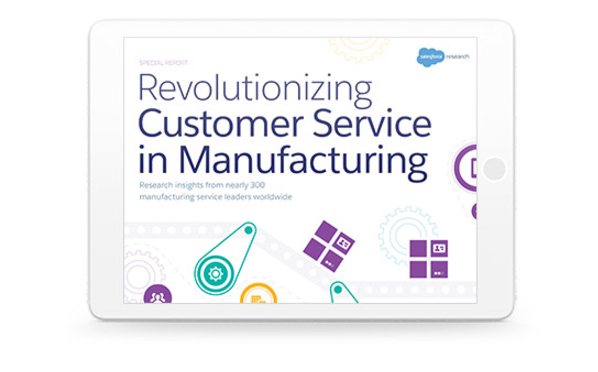There was time when delivering the best product, for the best price, was enough to keep any manufacturer ahead of the competition. But with many now reporting difficulties competing on product differentiation, and globalisation pushing prices down, forward-thinking companies are turning to services to help them stand out from the crowd.
This uber-trend towards ‘servitization’ – defined as ‘the strategy of creating value by adding services to products’ – is also big news for the field service industry.
As service becomes a new battleground for differentiation, the drive towards predictive, efficient, customer-centric operations is only going to accelerate, making ever greater use of tech, from the Internet of Things (IoT) to Augmented Reality (AR).
The shift toward service
Servitization is by no means a new phenomenon – Rolls Royce was adding services to its engines back in the dark ages of 1962 – but its widespread adoption is.
Our recent report, The State of Service in Manufacturing, found that 68% of manufacturers have increased service team budgets since 2014, and 69% expect to plough even more money into service over the coming two years.
Put simply, manufacturers are getting serious about customer service. And they’re not just doing it to win customer experience awards – our report also found that “74% of manufacturing executives believe that data-driven services will be their primary revenue source within 10 years”.
Who’s getting it right?
Dutch technology company Philips has always leant heavily on innovation to differentiate itself in the market, and their ‘Light-as-a-Service’ strategy continues this legacy. Introduced to Amsterdam-Schiphol airport in 2015, the collaboration between Schiphol Group, ENGIE and Royal Philips has seen the airport reduce its electricity consumption by 50%.
Freeing Schiphol Group from upfront costs and maintenance concerns, Philips retains all product ownership, while ENGIE help maintain lighting performance, upkeep, and the recycling of expired goods.
The service is complemented by added IoT connectivity in Philips’ lamps, allowing the manufacturer’s field service team to keep a close eye on lamp performance and usage, so the team can anticipate unit faults before they happen.
Servitization = IoT-powered Field Service
For many companies, delivering these types of proactive, connected, differentiated services will mean investing in, and powering up their field service operations. And that means harnessing the full potential of the IoT.
The number of manufacturing service teams using IoT experienced triple-digit growth from 2015 to 2016 – perhaps unsurprising given:
- 71% believe IoT data is extremely or every beneficial to increasing customer retention
- 67% say it’s very beneficial to offering a proactive service
- 66% say it helps them predict customers’ needs before they arise
What about Augmented Reality?
IoT isn’t the only new idea helping companies revolutionise their service offerings.
At Caterpillar Inc., AR is being used to help customers and service technicians operate and repair their portable generators. All they need is an AR-enabled device (like a tablet) to hold in front of the machine, and they instantly receive relevant guidance and information on screen.
When used together, IoT and AR have the potential to massively improve one of the most important of all field service KPIs, first-time fix rate – with the connected product reporting its own fault back to the service team, and the dispatched technician using AR to diagnose and resolve the problem on the spot.
No delays, no mistakes – just a service that helps the company to dramatically differentiate on customer experience.
Seizing the servitized future
These are exciting times in field service, as it becomes a principal battleground of competitive differentiation.
In the race towards servitization, companies bold enough to walk through the doors opened by IoT and AR look set to steal competitive advantage.
To help you blaze your own path, we surveyed nearly 300 manufacturing customer service professionals to understand the trends shaping the future of the industry. Disscover the habits of top manufacturing customer service teams, download the full report.








